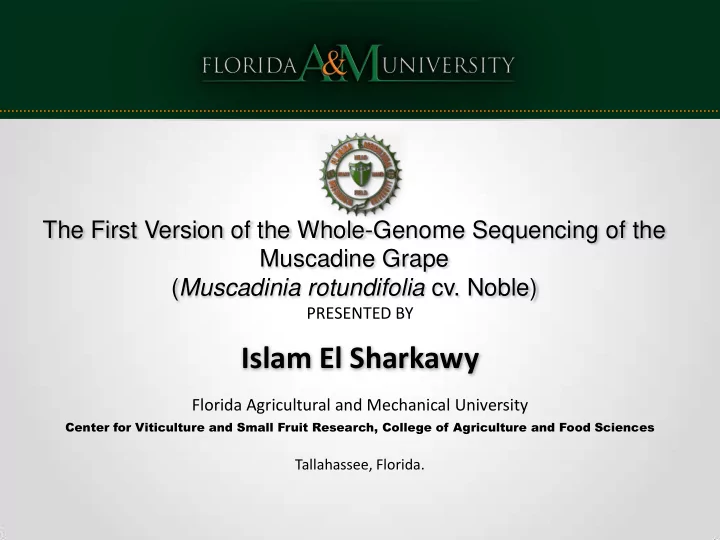

The First Version of the Whole-Genome Sequencing of the Muscadine Grape ( Muscadinia rotundifolia cv. Noble) PRESENTED BY Islam El Sharkawy Florida Agricultural and Mechanical University Center for Viticulture and Small Fruit Research, College of Agriculture and Food Sciences Tallahassee, Florida.
Our Muscadine Breeding Program Currently muscadine grapes is commercially grown in 12 states in the US. There is a demand for new muscadine cultivars with enhanced fruit/vinification qualities. Over the years, conventional breeding strategy has resulted in several muscadine cultivars suitable for table and wine markets with improved quality traits. However, the procedure is lengthy, laborious and expensive, which does not match with the rapid, ever-increasing industry needs. Our goal is capitalizing on the latest achievements of genomic technologies to develop breeding platform that meets the growing industry demands.
Grapevine Cultivars & Germplasm at CVSFR Adult a Juvenile b Background Total No. of Vines No. of Individual Genotypes No. of Cultivars Muscadinia hybrids 3925 2537 51 664 1877 Vitis hybrids 3380 2432 172 589 1843 Muscadinia x Vitis (MV) 106 106 - 103 3 a) 3-year old and /or elder; Reproductive Phase. b) 2-year old and or younger; Growth Phase.
Grape Muscadinia Genus (3) Euvitis Genus (14) M. rotundifolia V. vinifera M. munsoniana V. labrusca M. popenoei V. riparia V. aestivalis V. rupestris 40 chromosomes ( n =20) 38 chromosomes ( n =19) Morphological Differences : Leaves, flower type, tendrils, cluster size, berry size, and age of cutting for propagation.
Muscadinia sp. hold particular agronomical and reproductive traits: Resistance to most of diseases that limit the worldwide production of V. vinifera . Adapted to poor soil. Grow well under warm and humid conditions. Exotic fruit quality traits (berry size, unique flavor spectrum, therapeutic phytochemicals content). Unique vinification qualities.
Muscadines have obviously different challenges from those of traditional ‘ vinifera ’ grapes Cold hardiness. Extended ripening season. Perfect flower with large berry size. Fruit quality traits (diversity in berry color & shape, seedlessness, large cluster, thinner skin, dry stem scar, uniform ripening, extended shelf-life). Wet stem scar Male Male Fema emale le Perf erfec ect Photos by UGA CAES - University of Georgia
Whole – Genome Sequencing of Muscadine Grape Noble cv. Main red wine muscadine cultivar released by Nesbitt, 1973. Thomas ( ♀ ) x Tarheel ( ♂ ) Black small berries (3.8 – 4.3 g). High vigor growth. High yield (9.6 – 10.7 tone/acre). Disease resistant. Self-fertile (perfect flower). Stable purple pigments. Midseason. Suitable for wine and juice Uniform ripening. production.
Muscadine Genome Sequencing & Assembly
Muscadine Genome Assembly Statistics Estimated genome 414 Mb (82%) size V. vinifera Assembly Size 400.26 Mb (96.6%) M. rotundifolia Contig N50 107 kb Contig L50 1,011 contigs Scaffold N50 20.045 Mb Scaffold L50 9 Scaffold N90 16.486 Mb Scaffold L90 18 Number of scaffolds 1,629 Heterozygosity 1.47% Unplaced sequence 2.47% Contig gaps 8,168
Benchmarking Universal Single-Copy Ortholog (BUSCO) Assessment of muscadine genome assembly and gene set using BUSCOs indicates highly-complete representation of protein- coding genes. Statistics searching Embryophyta BUSCOs: 1382 Complete BUSCOs (96%). 1339 Complete and single-copy BUSCOs (93%). 43 Complete and duplicated BUSCOs (3%). 17 Fragmented BUSCOs (1.2%). 41 Missing BUSCOs (2.8%). 1440 Total BUSCO groups searched.
M. rotundifolia and V. vinifera display high colinearity The extra Muscadinia chromosome is composed of two large segments homologous to Vitis chromosome 7
Characterization of muscadine population A population of 400 muscadine genotypes (50 standard cultivars and 350 lines) has been carefully selected to ensure diversity and subjected to: 1. Phenomic Characterization Fertility traits (bud fertility, bud fertility coefficient, position of first fruiting bud); Cluster physical traits (intensity, size, weight, number and weight of berries/cluster); Berry physical traits (scar pattern, color, size, weight, number and weight of seeds/berry, firmness); 50 berries traits (berries weight, pomace weight, juice volume); Yield traits (No. of clusters/vine, yield/vine); and Berry quality traits (TSS, acidity, pH).
Characterization of muscadine population 2. Phenology traits Bud break. Fruit-set. Green shoot visible. Cluster closure. Visible inflorescences. Veraison. Partial bloom. Post-Veraison. Full bloom. Ripening. 3. Biotic stress traits Leaf roll virus (several strains); and Fungal diseases (powdery and downy mildew).
Characterization of muscadine population 4. Metabolomic and sensorial traits Aroma volatile esters production. Total phenolic. Total flavonoid. Antioxidant activity. Antimicrobial activity ( E. coli ). Anticancer activity (Breast cancer cell lines MDA-MB-231 and MDA-MB-468).
Anticancer activity of muscadine extracts using African American breast cancer cell lines
Classification of muscadine genotypes based on their anticancer activity 53-75% 55-60% 0-19% 50-91%
Undergoing Generating Pacbio Iso-seq and Illumina RNA-seq data on multiple tissues to generate accurate and comprehensive gene predictions. Performing ATAC-seq (Assay for Transposase-Accessible Chromatin using sequencing) to determine the chromatin accessibility of muscadine genome. Analyzing of M. rotundifolia genes’ PAV (presence-absence variation) and their predicted functions compared to V. vinifera . Complete QC analysis and submission to Phytozome.
Acknowledgement
Team Members D. Vera D. Kambiranda V. Tsolova I. El-Sharkawy
Recommend
More recommend